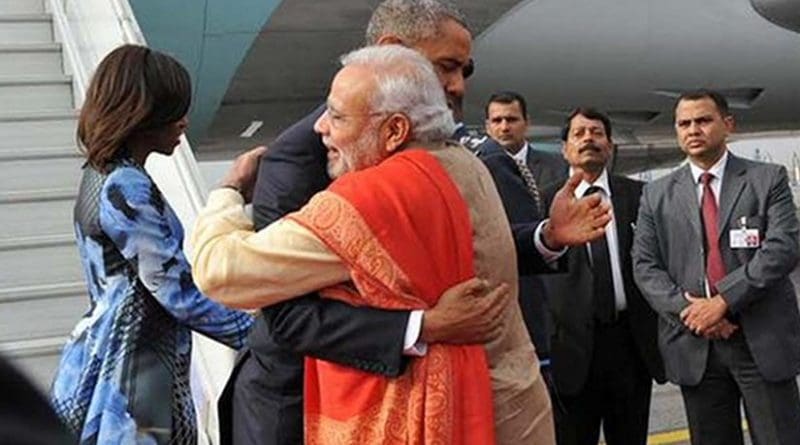India And US: From Good Friends To Best Friends? – Analysis
By Rashmi Saksena*
On the face of it, India and the US have much to showcase to prove that over the last 18 months there has been an emergence of a closer partnership between the two countries which have historically often been polar opposite in strategic thinking and global perspectives. Several mechanisms have been put in place during the past months to resolve differences on political, economic, environmental, security and social affairs.
This brings up a question which will impact the relationship in the long run. Does New Delhi continue to look at the bilateral relationship through the Islamabad prism as it has traditionally done so? The answer is yes in the limited albeit crucial context of what Washington doles out to Pakistan in the form of financial aid, defence equipment and its initiatives to pressurize Islamabad to reign in terror from its soil directed at India.
It was as recently as February 13, 2016, that India summoned US Ambassador Richard Verma to conveyed its “displeasure and disappointment” over President Barack Obama’s decision to sell eight nuclear capable F-16 fighter jets worth USD 700 million to Pakistan. Foreign Secretary S. Jaishankar summoned Verma to his South Block office to tell him about India’s concerns over US military aid to Pakistan which New Delhi holds goes into anti-India activities. External Affairs Ministry also issued a strong statement expressing its disappointment over the US decision. It made it evident that it disagrees with the Obama administration’s rationale that these arms transfer to Pakistan will help in combating terrorism.
Verma not only sought to allay India’s disquiet over these issues here this week but also urged the relationship not to be viewed and evaluated anymore through the Pakistani prism. Verma was delivering the Fourth Annual Lecture of the Indian Association of Foreign Affairs Correspondents. He emphasized that the India-US security relationship is of a fundamentally different nature than what it has with any other country in the region. Instead of limiting this relationship to supplying defence platforms it is helping to support the development of indigenous defence industrial capabilities that India “will need to become the 21st century power it aspires to be”.
A naval aviation programme, air superiority, heavy lift, jet engine production are areas of defence where the US is actively supporting Indian forces. He highlighted the forward movement in the defense relationship. America has offered to provide Indian air Force with Apache attack helicopters (the most advanced helicopter in the US inventory), Chinook heavy lift helicopters and M777 howitzers. The US has never in its history actively supported the indigenous development of an aircraft programme in another country but has done so for India to support it an emerging defense leader.
All this will lead to cooperative development of state-of-the-art warships with advanced launch and landing systems, proven defense capabilities and fighter aircraft that. Pointing out that the military ties between the two countries are becoming increasingly close he announced that in April the US Secretary of Defense Ashton Carter will be visiting India for an unprecedented third visit in less than a year. A road map for the implementation of the Joint Strategic Vision for the Asia Pacific and Indian Ocean Regions has also been concluded.
Addressing terrorism emanating from Pakistan, the thorny issue that derails the peace process between the neighbours, Verma made it clear that Washington is far from satisfied with what Islamabad has done to stem it. Pakistan needs to do much more to convince the US that it is serious about dismantling, disrupting and delegitimizing terrorist groups and networks operating from Pakistan territory. He stated that “we (US) have to work on it”.
India has voiced its concerns over Pakistan’s segregated approach to fighting terror outfits. The approach is evident from its joint military operation, Zarb-e-Azb, launched June 15, 2014 to flush out militants from North Waziristan along its border with Afghanistan. While cracking down on outfits that have attacked Pakistan establishments it has not yet dealt with the likes of Jaish-e-Mohammed that target India. Zarb-e-Azb was launched after the June 8, 2014 militant attack on the Jinnah International Airport, Karachi. It is focused on Tehrik-i-Taliban Pakistan, Islamic movement of Uzbekistan, east Turkestan Islamic Movement, Lashkar-e-Jhangvi, al Qaeda and the Haqqani network.
*Rashmi Saksena is an Associate Director at the Society for Policy Studies, New Delhi. She can be reached at: [email protected]

